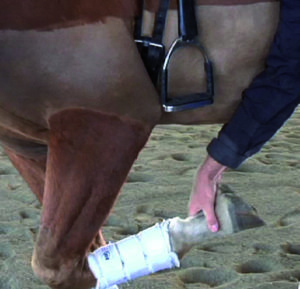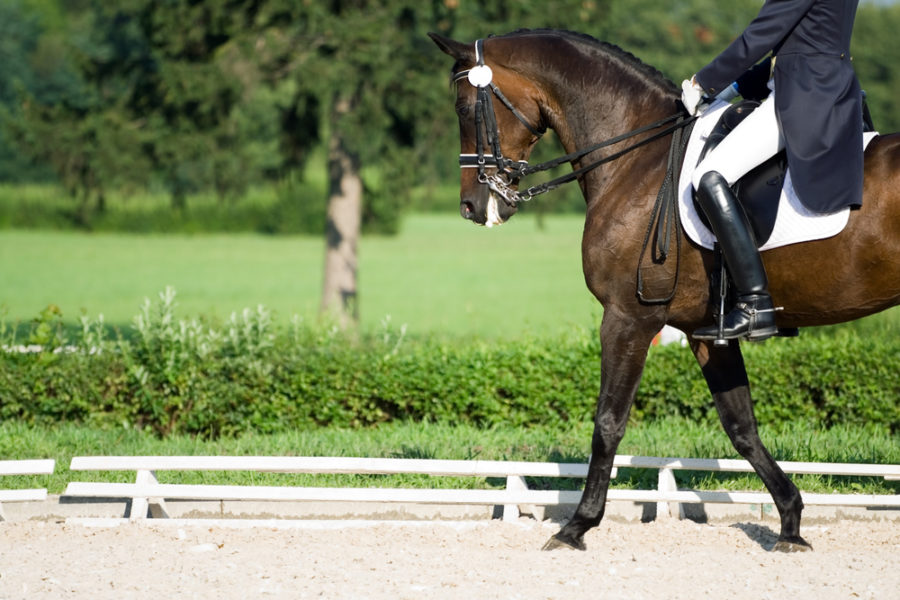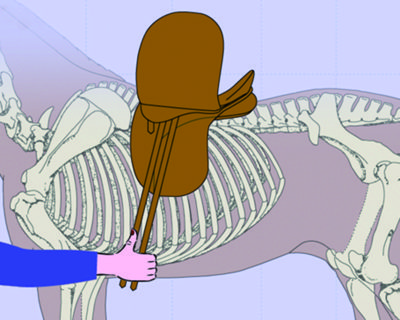The girth directly affects saddle fit. Here’s how to find one that works for your horse.
The girth is the most important saddle accessory because it directly affects saddle fit and how it feels to your horse. There are many different types, lengths and versions of girths available. In this article, we look at the factors to consider when finding and fitting a girth that will work for your horse.
Billet alignment
One cannot really discuss girths without considering how the girth is attached to the saddle. Ask yourself:
- Does your saddle slide forward no matter what kind of girth you use?
- Have you ever had to stop in the middle of your ride and reset your saddle because it has moved forward onto your horse’s shoulders?
If you answered “yes” to either of these questions, you may be faced with a billet alignment issue – a crucial consideration regardless of what girth you choose. Unless the billets on your saddle are positioned correctly, your saddle will not stay in its proper place on your horse’s back. And no matter how many times you stop and reset the saddle, or what type of girth you use, your saddle will continue to slide forward.
Checking billet alignment
To find out if the billets on your saddle are aligned properly for your horse, place your saddle on the horse’s back, making sure it is correctly situated behind his shoulder. The billets should hang perpendicular to the ground in the girthing area. If they hang too far back, gravity will pull them forward into the girthing area, which will pull the entire saddle forward. The girth will always find its position at the narrowest point of the rib cage behind your horse’s elbow, and the unfortunate result is that the saddle either gets driven forward into your horse’s shoulders, or driven clear on top of his shoulders.
Why does this matter? The horse’s shoulder blade (scapula) consists of both bone and cartilage. At the very least, a saddle that is pulled forward onto his shoulders acts like a straitjacket: your horse will be unable to move freely through his shoulders and his movement will be compromised, sometimes severely.
At worst, a saddle that constantly drives into your horse’s shoulders first will produce a buildup of scar tissue on his scapula. If the problem persists over the long-term, the tree points of the saddle will begin to actually chip away the bone and cartilage. Horses with this kind of irreversible damage often have telltale “holes”, particularly on the left shoulder blade.
If the billets hang too far forward into your horse’s elbow area, they may make him sore in the elbows. And once again, gravity will drag them (and the girth and saddle along with them) back into the girthing area. You might think this is not a problem because at least your horse’s shoulders are free. However, there will be too much pressure on the panels at the rear of the saddle. Too much of the rider’s weight will be on the horse’s lumbar and kidney area. This is especially problematic when your mare is in season, since this excess pressure on her ovaries may cause her to show extreme discomfort or resistance when being saddled and ridden.
What causes improper billet alignment? Frequently, the problem is that either the width or angle of your saddle tree, or both, are not the correct size for your horse. Work with a saddle fitter to ensure the saddle you are using has a tree correctly sized for your horse.
Billet length
Girths comes in many sizes, shapes and designs. When you girth a saddle with long billets, the girth should be at the last two to three holes of the billets. One of the highest points of heat and friction occurs where the billets lie against the edge of the horse. Less distance between the bottom of the flap and the top of the girth means less irritation. Every saddle has a different flap and billet length depending on the manufacturer. Try different lengths, shapes, and materials to see what girth works with your horse.

A horse has a curved shape with relief needed in the elbow area — an area easily chafed by the girth. It is necessary to have a girth with an area cut out behind the elbow. This allows the horse to move the front leg without being inhibited by the girth itself.
Girth shape
In this diagram, Girth B is preferable to Girth A. Girth A is very straight with only one strip of hard leather through the center, putting all the pressure onto that thin leather strap and acting like a “knife” across a horse’s sternum and pectorals. Girth B has cut-outs for the elbow. The stiffer leather goes all the way out to the edges with a soft leather backing that disperses the pressure over a much larger surface area, making the horse more comfortable. The wider center also helps stabilize a saddle from slipping side to side or going forward.
A correctly shaped girth should displace pressure as evenly as possible along its length. Ideally, it should have a wider surface area along the sternum of the horse, which is the strongest point of contact. These “diamond” girths are anatomically accommodating, narrower at the ends where they sit under the elbow area, and widening to between 4” to 8” inches at the sternum to evently displace the pressure.
Rider beware!
The girth can be a significant cause of skin irritations. This can occur when:
- the billets are not in the right spot
- the girth is the incorrect shape
- the girth alignment does not match up.
The more a girth is able to distribute weight and pressure over a larger surface area, the more comfortable the horse will be.

The ends of the girth — elastic or no elastic?
A girth has the potential to put immense pressure on the horse’s musculature; therefore, it should displace this pressure as evenly as possible along its length. With no elastic at the ends of a girth, there is no give at all once a saddle is girthed up. This means we have a solid leather band around the horse’s ribcage and around his lungs. A horse may be short of breath or irritable after being ridden in this type of girth, because of breathing issues.
A girth with at least one side elastic is both better and worse. The advantage is that the ribcage has room to expand; the downside is that the give is only on one side and therefore can pull the saddle off to that side and cause unevenness in the horse’s movement and development. Best is a girth with both sides elastic. If the elastic is too weak or too long, the girth loses stability and stretches, allowing the saddle to move around on the horse’s back. On a short girth, the elastic should be a maximum of 1” long; on a long girth the elastic should be a maximum 2 1/2” long. This gives the ribcage room while keeping the saddle stable. Watch for fraying at the elastic and buckle attachments.

Matching girth and billet length
The area where the girth is positioned and buckled is where several muscle groups converge and have their sensitive points – an area we should avoid irritating. The longer girth used with jumping and eventing saddles is usually buckled on the sweat flap, which means there is a relatively thick second leather layer protecting the horse’s flank from the buckle.
In dressage, short girths with long billets are the rule. A huge advantage is that the girth’s buckles don’t bother the rider at his thighs and allow the saddle to be fastened more securely. However, the girth buckles are located at a very sensitive area of the horse’s rib cage. A short girth is buckled directly on the side of the horse, so the buckle (which may be protected minimally with one layer of leather) may cause pressure. The girth should be buckled to the billets as close to the widest part of the horse’s side as possible (as high up as possible) so the buckles are “pulled away” from the rib cage and won’t put unnecessary pressure on his side and the insertion points (edge) of the M. Pectoralis profundus, but rather on its mass (flatness) – for example, the pectoralis or latissimus. The buckles should never cause pressure points to the horse or rider, or interfere with riding and moving freely without pain.











